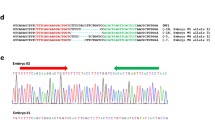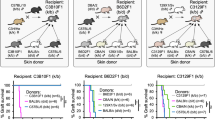Abstract
Porcine skin is frequently used as a substitute of human skin to cover large wounds in clinic practice of wound care. In our previous work, we found that transgenic expression of human cytoxicT-lymphocyte associated antigen4-immunoglobulin (hCTLA4Ig) in murine skin graft remarkably prolonged its survival in xenogeneic wounds without extensive immunosuppression in recipients, suggesting that transgenic hCTLA4Ig expression in skin graft may be an effective and safe method to prolong xenogeneic skin graft survival. In this work, using a transgene construct containing hCTLA4Ig coding sequence under the drive of human Keratine 14 (k14) promoter, hCTLA4Ig transgenic pigs were generated by somatic nuclear transfer. The derived transgenic pigs were healthy and exhibited no signs of susceptibility to infection. The hCTLA4Ig transgene was stably transmitted through germline over generations, and thereby a transgenic pig colony was established. In the derived transgenic pigs, hCTLA4Ig expression in skin was shown to be genetically stable over generations, and detected in heart, kidney and corneal as well as in skin. Transgenic hCTLA4Ig protein in pigs exhibited expected biological activity as it suppressed human lymphocyte proliferation in human mixed lymphocyte culture to extents comparable to those of commercially purchased purified hCTLA4Ig protein. In skin grafting from pigs to rats, transgenic porcine skin grafts exhibited remarkably prolonged survival compared to the wild-type skin grafts derived from the same pig strain (13.33 ± 3.64 vs. 6.25 ± 2.49 days, P < 0.01), further indicating that the transgenic hCTLA4Ig protein was biologically active and capable of extending porcine skin graft survival in xenogeneic wounds. The transgenic pigs generated in this work can be used as a reproducible resource to provide porcine skin grafts with extended survival for wound coverage, and also as donors to investigate the impacts of hCTLA4Ig on xenotransplantation of other organs (heart, kidney and corneal) due to the ectopic transgenic hCTLA4Ig expression.








Similar content being viewed by others
References
Abrams JR, Lebwohl MG, Guzzo CA, Jegasothy BV, Goldfarb MT et al (1999) CTLA4Ig-mediated blockade of T-cell costimulation in patients with psoriasis vulgaris. J Clin Invest 103:1243–1252
Betthauser J, Forsberg E, Augenstein M, Childs Y, Eilertsen K et al (2000) Production of cloned pigs from in vitro system. Nat Biotechnol 18:1055–1059
Cooper DKC, Good AH, Koren E et al (1993) Identification of α-galactosyl and other carbohydrate epitopes that are bound by human anti-pig antibodies: relevance to discordant xenografting in man. Transpl Immunol 1:198–205
Desai MH, Herndon DN, Broemeling L et al (1990) Early burn wound excision significantly reduces blood loss. Ann Surg 211:753–759
Genovese MC, Becker JC, Schiff M, Luggen M, Sherrer Y et al (2005) Abatacept for rheumatoid arthritis refractory to tumor necrosis factor alpha inhibition. N Engl J Med 353:1114–1123
Good AH, Cooper DK, Malcolm AJ et al (1992) Identifi cation of carbohydrate structures that bind human antiporcine antibodies:implications for discordant xenografting in man. Transpl Proc 24:559–562
Guo L, Fujino M, Kimura H, Funeshima N, Kitazawa Y et al (2003) Simultaneous blockade of co-stimulatory signals, CD28 and ICOS, induced a stable tolerance in rat heart transplantation. Transpl Immunol 12:41–48
Jiang W, Zhou XY, Wang LL, Liu Q, Liu CE, Wang Y, Wei H (2012) Skin-specifically transgenic expression of biologically active human cytoxic T-lymphocyte associated antigen4-Immunoglobulin(hCTLA4Ig) in mice using lentiviral vector. Transgneic Res 21:579–591
Jin YZ, Xie SS (2003) Bicistronic adenovirus-mediated gene transfer of CTLA4Ig gene and CD40Ig gene result in indefinite survival of islet xenograft. Transpl Proc 35:3165–3166
Konigova R, Matouskova E, Broz L (2000) Burn wound coverage and burn wound closure. Acta Chir Plast 42:64–68
Kremer JM, Dougados M, Emery P, Durez P, Sibilia J et al (2005) Treatment of rheumatoid arthritis with the selective costimulation modulator abatacept: twelve-month results of a phase IIb, double-blind, randomized, placebo-controlled trial. Arthritis Rheum 52:2263–2271
Lai LX, Kolber-Simonds D, Park KW, Cheong HT, Greenstein JL et al (2002) Production of apha 1,3-galtransferase knock-out pigs by nuclear transfer cloning. Science 295:1089–1092
Larsen CP, Pearson TC, Adams AB, Tso P, Shirasugi N et al (2005) Rational development of LEA29Y (belatacept), a high-affinity variant of CTLA-4Ig with potent immunosuppressive properties. Am J Transpl 5:443–453
Lenschow DJ, Zeng Y, Thistlethwaite JR, Montag A, Brady W et al (1992) Long-term survival of xenogeneic pancreatic islet grafts induced by CTLA4lg. Science 257:789–792
Luo GX, Wu J, Chen XW et al (2005) CTLA4Ig introduced by adenoviral vector locally to prolong the survival of xenogeneic skin grafts on rat burn wounds. J Trauma 59:1209–1215
Martin C, Plat M, Nerrie`re-Daguin V, Coulon F, Uzbekova S et al (2005) Transgenic expression of CTLA4-Ig by fetal pig neurons for xenotransplantation. Transgenic Res 14:373–384
Orgill DP (2009) Excision and skin grafting of thermal burns. N Engl J Med 360:893–901
Phelps CJ, Ball SF, Vaught TD, Vance AM, Mendicino M et al (2009) Production and characterization of transgenic pigs expressing porcine CTLA4Ig. Xenotransplantation 16:477–485
Ruperto N, Lovell DJ, Quartier P, Paz E, Rubio-Perez N et al (2008) Abatacept in children with juvenile idiopathic arthritis: a randomised, double-blind, placebo-controlled withdrawal trial. Lancet 372:383–391
Stell D, Marshall H, Bradley JA, Bolton EM (2003) CTLA4-Ig abrogates the anti-globulin response and prolongs cardiac allograft survival after anti-CD2 treatment. Transpl Immunol 12:1–7
Turka LA, Linsley PS, Lin H, Leiden JM, Brady W et al (1992) T-cell activation by the CD28 ligand B7 is required for cardiac allograft rejection in vivo. Proc Natl Acad Sci USA 89:11102–11105
Wallence PM, Linsly PS, Iohnson J (1992) Immuno suppression in vivo by a soluble form of the CTLA4 T cell activation molecule. Science 257:792–797
Wang YF, Xu AG, Hua YB, Wu WX (2004) Effect of local CTLA4Ig gene transfection on acute rejection of small bowel allografts in rats. World J Gastroenterol 10:885–888
Wang Y, Wang FC, Wei H, Ni Y, Wu J et al (2005) Establishment of transgenic mouse line skin-specifically expressing hCTLA4-Ig. Acta Genet Sin (Yi Chuan Xue Bao) 32:916–922
Wang Y, Ni Y, Wei H, Wang FC, Ge LP et al (2006) Stable skin-specific overexpression of human CTLA4-Ig in transgenic mice through seven generations. Acta Biochem Biophys Sin 38:171–178
Wang YB, Ogawa Y, Kakudo N, Kusumoto K (2007) Survival and wound contraction of full-thickness skin grafts are associated with the degree of tissue edema of the graft bed in immediate excision and early wound excision and grafting in a rabbit model. J Burn Care Res 28:182–186
Wang Y, Wei H, Ni Y, Ge LP, Liu Q et al (2008) Transgenic expression of CTLA4Ig prolongs xenogeneic skin graft survival without extensive immunosuppression in rat burn wounds. J Trauma 165:154–162
Weiner J, Yamada K, Ishikawa Y et al (2010) Prolonged survivial of GalT-KO swine skin on baboons. Xenotransplantation 17:147–152
Weisman MH, Durez P, Hallegua D, Aranda R, Becker JC et al (2006) Reduction of inflammatory biomarker response by abatacept in treatment of rheumatoid arthritis. J Rheumatol 33:2162–2166
Acknowledgments
This work was supported by grants from National 863 Project of China (2012AA020504), Natural Science Fund of China (NSFC, 31171280), National 973 Project of China (2011CB944102), Chongqing Natural Science Fund(cstc2011jjA10049), International Science and Technology Cooperation Program of China (S2013ZR0398), Advancing Research in Basic Science of Chongqing (cstc2013jcyjC80001) and Chongqing Agriculture Development Fund (12402).
Author information
Authors and Affiliations
Corresponding authors
Additional information
Yong Wang and Hua-Qiang Yang have contributed equally to this work.
Rights and permissions
About this article
Cite this article
Wang, Y., Yang, HQ., Jiang, W. et al. Transgenic expression of human cytoxic T-lymphocyte associated antigen4-Immunoglobulin (hCTLA4Ig) by porcine skin for xenogeneic skin grafting. Transgenic Res 24, 199–211 (2015). https://doi.org/10.1007/s11248-014-9833-9
Received:
Accepted:
Published:
Issue Date:
DOI: https://doi.org/10.1007/s11248-014-9833-9




